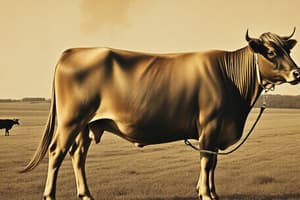Podcast
Questions and Answers
What is the main characteristic of the post-embryonic growth phase?
What is the main characteristic of the post-embryonic growth phase?
Rapid growth and development of various tissues and organs at different growth rates.
Why do organs like the nervous system, heart, liver, and kidneys develop rapidly during the embryonic phase?
Why do organs like the nervous system, heart, liver, and kidneys develop rapidly during the embryonic phase?
Because they provide an important functional role before birth.
What is the typical growth curve of an animal after birth?
What is the typical growth curve of an animal after birth?
An 's'-shaped curve, with slow growth, rapid growth, and then slow growth again.
What happens during the final stage of growth?
What happens during the final stage of growth?
How do animals with longer gestation periods differ from those with shorter gestation periods?
How do animals with longer gestation periods differ from those with shorter gestation periods?
What is the approximate weight range of a cow during Stage 2 of growth?
What is the approximate weight range of a cow during Stage 2 of growth?
What is the order of tissue development during Stage 2 of growth?
What is the order of tissue development during Stage 2 of growth?
During which stage do animals' muscles reach about 80% to 90% of their full development?
During which stage do animals' muscles reach about 80% to 90% of their full development?
What is the main difference between Stage 3 and Stage 4 of growth?
What is the main difference between Stage 3 and Stage 4 of growth?
How do the growth stages of different animals vary?
How do the growth stages of different animals vary?
Flashcards are hidden until you start studying




